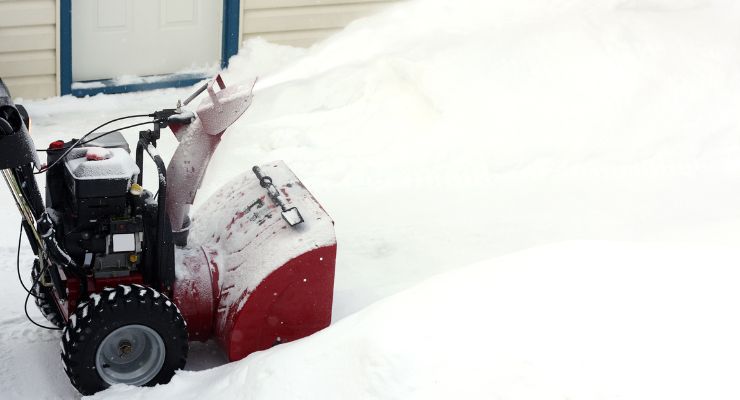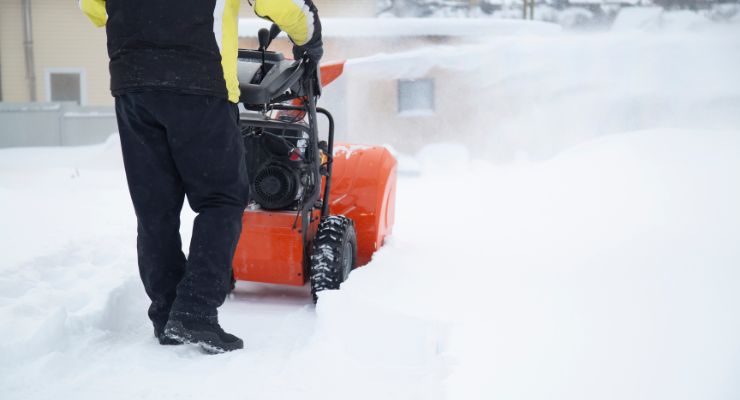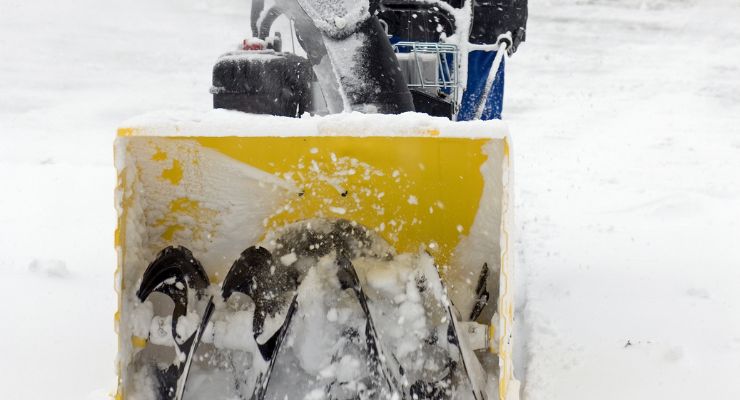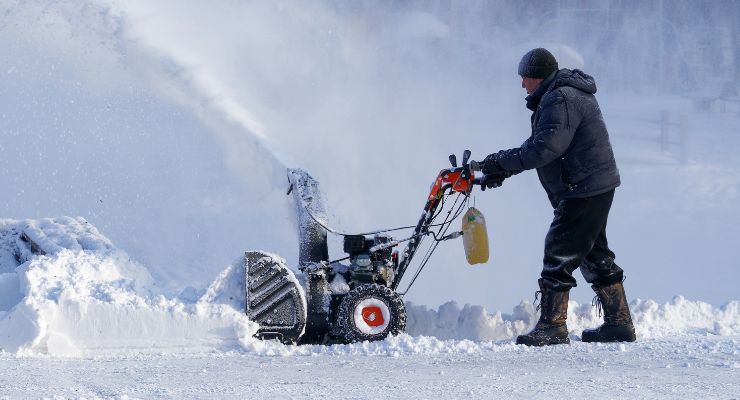To ensure a longer lifespan, storing your snow blower correctly at the end of each season is paramount.
The key to this process?
Draining the gas tank properly before putting it away! Otherwise, stale fuel will damage both its carburetor and engine.
Why You Should Drain Gas from Snow Blowers
Leaving gas in the tank over the winter can lead to a variety of issues for the next season.
Gasoline has a shelf life of three to six months, but after that, it can begin to degrade. In the U.S., most gas contains ethanol, which is prone to moisture absorption and corrosion and can further decrease the shelf life of gas to a shocking 30 days.
Stale gasoline can gum up your carburetor, making it challenging (and expensive) for you when starting your snow blower again – not something anyone desires!
To prevent any potential problems, it is essential to drain the gas from your snow blower before winterizing it for storage.
Keeping Gas in the Snow Blower off Season
It’s possible to maintain gasoline in snow blowers during their off-season, but it is strongly recommended that you use a fuel stabilizer when storing your machine for a long period.
These helpful products will prevent the degradation of gas and ensure that its freshness lasts until you need it again! With this small effort now, you can save yourself valuable time later on.
To keep your snow blower’s engine in the best possible condition, add the suggested amount of fuel stabilizer to its gas tank.
Let it run for a few minutes so that treated gas is circulated throughout. In this way you can both extend the life of your petrol and protect your snow blower during periods without use!
Even though fuel stabilizer may be effective, we still suggest that you empty the gas tank after each season for best results.

How to Drain Gas from Snowblower With Siphon Pump
Before You Begin
Read the manual
Prior to draining the gas from your snow blower, be sure to consult its manufacturer’s manual for any special instructions or safety precautions.
This will guarantee that you are taking all necessary steps and not putting your equipment at risk of unnecessary damage.
Find a location
After that, you can look for a suitable spot to begin your task. Select a firm and even surface with proper ventilation far from any fire points or potential ignition sources.
Make sure there is enough room around you so that all the required materials are nearby and clearly accessible.
Safety first
To ensure your safety, do not forget to prioritize precautions. Gas is immensely combustible and can be hazardous when in the wrong hands; consider donning gloves while handling it and abstain from smoking or using open flames around it.
If you feel disoriented by the process at any moment, seek help from a professional who has experience working with gas – this could save you time and energy!
What you will need
To drain gas from a snowblower, you will typically need the following items:
- Siphon pump: A siphon pump is a practical and effective tool used to transfer liquids from one container to another via the utilization of vacuum pressure.
- A suitable container for the gas: To safely store gasoline, you need a container that is secure and reliable. A gas can with a properly-fitted lid is an ideal choice for this purpose.
- A pair of gloves: It is essential to wear gloves when handling gasoline, as it can be damaging and dangerous for your skin.
- A funnel: A funnel is an incredibly useful tool when transferring gasoline into a container, especially if you’re in a tight area.
- A shop towel or rags: With these, you can easily clear up any messes and wipe down the fuel line as well as other components of the snowblower after draining its gas.
- An adjustable wrench or pliers: You may need a tool to loosen the bolt or screws that hold the fuel line in place. An adjustable wrench or a pair of pliers should do the trick.
- Earplugs: To help safeguard your ears from the loud noise of a snow blower, it’s wise to wear earplugs while operating one.
- Eye protection: To prevent any splashes or spills from damaging your eyes, wear safety goggles or glasses throughout the process.
- Proper clothing and wear: Use tight clothing and a sturdy boot for good grip.

Step by Step Instructions
Hopefully you have followed the “Before you begin” instructions, such as finding a suitable location, reading the manual, considering safety measures and clothing, and have your tools and gas container or catch pan ready.
Make sure the engine is turned off and is cool.
Now let’s get on with the job.
Open the gas tank
Locate the gas cap of your snowblower and unscrew it.
Siphon the gas from the tank
To safely transfer the residual fuel from the tank to a container, use your siphon pump. Remove the fuel cap and filter, grip the siphon firmly in one hand and secure it with your other as you press down on and into the container.
Be sure to read any accompanying user manuals for further instructions!
Run the engine dry (optional)
If the manufacturer permits it, running an engine dry can be beneficial in clearing out any remaining gas from the fuel system.
However, this should only be done after consulting with your manual to ensure that it won’t damage your carburetor or fuel system.
Running an engine dry is a great way to make sure no old gasoline lingers within and clogs up its systems!
Alternatively, if you have experience in small motor repair and maintenance, you can use a wrench and pliers to disassemble the fuel lines, drain out all of the corrosive material from the carburetor and make sure that no trace remains.
Clean up and safely dispose
When the gas has been removed, be sure to dispose of it in accordance with local laws and regulations for optimal safety.
Store the snow blower properly off-season
When you’re done with your snow blower for the season, take a few extra steps to properly store it away.
Add fuel stabilizer to the empty tank as outlined by its manufacturer in order to halt corrosion and gummed-up carburetors.
Be sure that the area where you keep it is dry and cool (not freezing!), under cover or sheltered from outdoor elements. With these tips in mind, your snow blower will be ready when winter rolls around again.

FAQs
Should You Drain Gas from Snowblower?
To keep your snowblower in perfect condition and avoid costly repairs, be sure to drain the fuel at the end of each season.
If you don’t add a stabilizer, untreated ethanol will build up causing corrosion and clogging which may lead to difficulty starting when it’s needed most.
Taking preventative measures now is key for saving time (and money) down the road!
Can You Mix Old Gas with New Gas in a Snowblower?
Avoid mixing old and new fuel in your snowblower, as the results could be hazardous. Fresh gas delivers significantly more power than its aged counterpart which may not have any combustibility left at all!
Blending these two types of fuel can cause your machine to malfunction or even prevent it from starting up altogether.
To guarantee top-notch performance this winter season, make sure you never mix fresh gasoline with older gasoline!
What do I do if I left the Gas in My Snowblower?
To prevent deposits and gum clogging in your snowblower, the best solution is to drain old fuel tank from the carburetor bowl and refill it with a stabilized fuel before running it for 10-15 minutes.
This will make sure that the new gas has been spread out throughout its system.
Nevertheless, this process can’t guarantee future hassle-free operation; however, doing so can help avoid potential issues down the line.
What is the Difference Between a Siphon Hose and a Siphon Pump?
Unlike a manual siphon hose, which requires the user to manually create suction and initiate liquid transfer by sucking on one end of the tube, a siphon pump is a more comfortable mechanism that automatically creates pressure and transfers liquids with ease.
This device eliminates any need for a human to risk getting gas into their mouth, as it sets up frictionless flow between two containers with just the press of its pump.
Conclusion
To maintain your snow blower in peak condition, draining the gas at the end of each season is a must. You can use either a siphon hose or pump to achieve this goal; running out all fuel if allowed by its manufacturer, disassembling any fuel lines and eliminating leftover gas will help lessen corrosion and blocked carburetors.
Before storing your snowblower for the off-season, make sure that you have removed all of the gas and disposed it as per local laws. Once accomplished, place your blower in a sheltered dry spot with fuel stabilizer if desired. By following these steps, you will be prepared to take on winter when its time comes!

